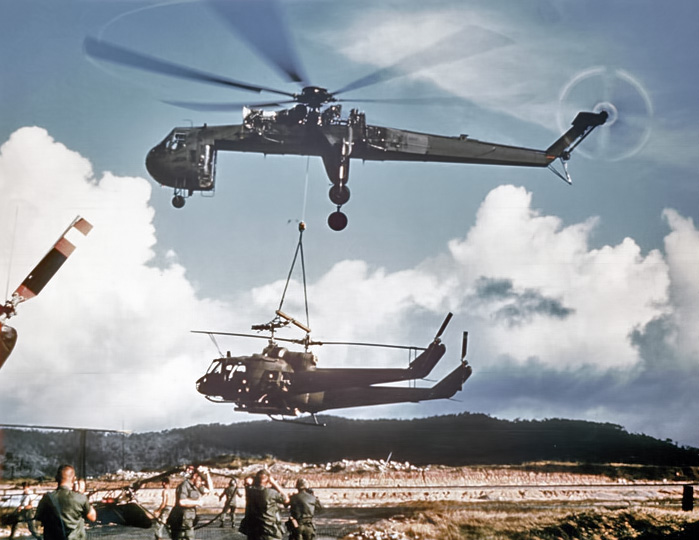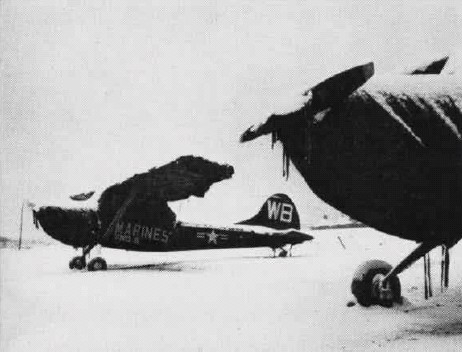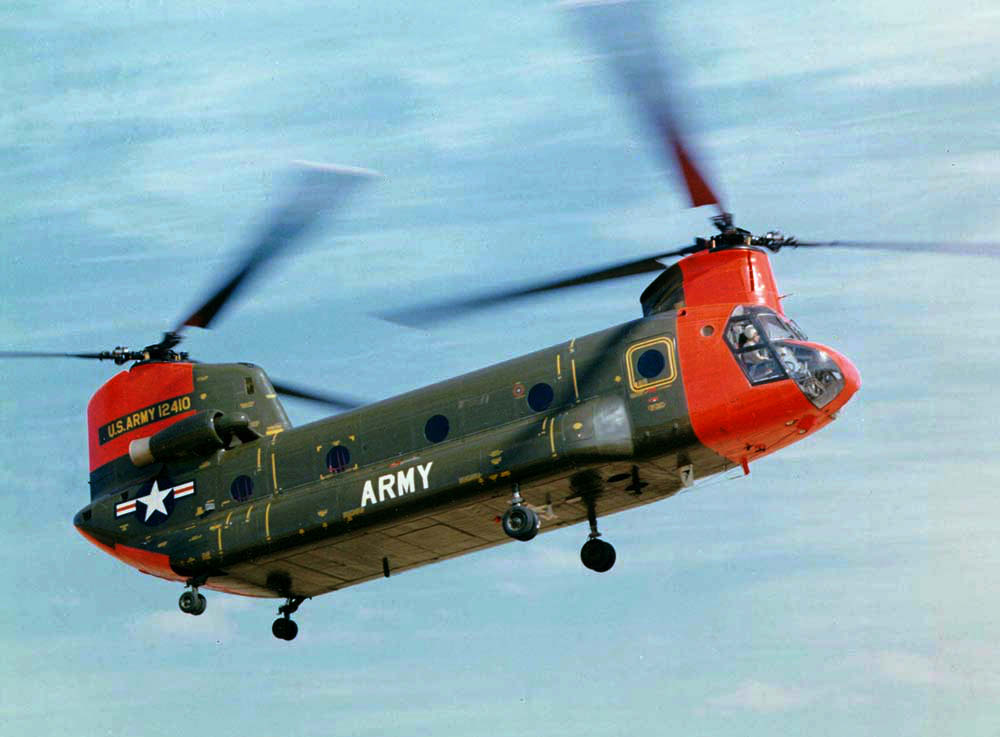|
Camp Holloway
Camp Holloway is a former U.S. Army base near Pleiku in central Vietnam. History Camp Holloway was established in 1962. It was located along Route 19 approximately 3km east of Pleiku in the Central Highlands of Vietnam. The camp was named in 1963 for Piasecki CH-21 helicopter pilot Warrant Officer Charles E. Holloway, who in December 1962 became the first aviator assigned to the 81st Transportation Company to be killed in action. The 81st Transportation Company, re-equipped in 1963 with UH-1 helicopters, later became the 119th Assault Helicopter Company. A Viet Cong attack in the early morning hours of February 7, 1965, killed seven, wounded 104 and destroyed 10 aircraft. This prompted U.S. President Lyndon B. Johnson to begin bombing North Vietnam. In December 1965 the 170th Aviation Company joined with the 119th to create the 52nd Aviation Battalion. The base eventually expanded to house the headquarters of the 52d Combat Aviation Battalion, now part of the 17th ... [...More Info...] [...Related Items...] OR: [Wikipedia] [Google] [Baidu] |
4th Infantry Division (United States)
The 4th Infantry Division is a division of the United States Army based at Fort Carson, Colorado. It is composed of a division headquarters battalion, three brigade combat teams (two Stryker and one armor), a combat aviation brigade, a division sustainment brigade, and a division artillery. The 4th Infantry Division's official nickname, "Ivy", is a play on words of the Roman numeral ''IV'' or 4. Ivy leaves symbolize tenacity and fidelity which is the basis of the division's motto: "Steadfast and Loyal". The second nickname, "Iron Horse", has been adopted to underscore the speed and power of the division and its soldiers. World War I The 4th Division was organized at Camp Greene, North Carolina on 10 December 1917 under the command of Maj. Gen. George H. Cameron. It was here they adopted their distinctive insignia, the four ivy leaves. The ivy leaf came from the Roman numerals for four (IV) and signified their motto "Steadfast and Loyal". The division was organized a ... [...More Info...] [...Related Items...] OR: [Wikipedia] [Google] [Baidu] |
Operation Flaming Dart
Operation Flaming Dart was a U.S. and South Vietnamese military operation, conducted in two parts, during the Vietnam War. Background United States President Lyndon B. Johnson in February 1965 ordered a series of reprisal air strikes after several attacks on U.S. bases by Vietcong units, particularly in reply to the Viet Cong Attack on Camp Holloway. Operation Forty-nine retaliatory sorties were flown for Flaming Dart I on 7 February 1965. Flaming Dart I targeted North Vietnamese army bases near Đồng Hới, while the second wave targeted Vietcong logistics and communications near the Vietnamese Demilitarized Zone (DMZ). Among the pilots was Republic of Vietnam Air Force (RVNAF) Air Marshal Nguyễn Cao Kỳ, then a member of Vietnam's ruling junta. U.S. Navy aircraft carriers launched aircraft for strikes on the barracks at Vit Thu Lu and Đồng Hới, both just north of the DMZ. The attack on Vit Thu Lu was cancelled because of heavy clouds over the target. The weather w ... [...More Info...] [...Related Items...] OR: [Wikipedia] [Google] [Baidu] |
Installations Of The Army Of The Republic Of Vietnam ) or political one
{{disambig ...
Installation may refer to: * Installation (computer programs) * Installation, work of installation art * Installation, military base * Installation, into an office, especially a religious (Installation (Christianity) Installation is a Christian liturgical act that formally inducts an incumbent into a new role at a particular place such as a cathedral. The term arises from the act of symbolically leading the incumbent to their stall or throne within the cathedra ... [...More Info...] [...Related Items...] OR: [Wikipedia] [Google] [Baidu] |
Installations Of The United States Army In South Vietnam ) or political one
{{disambig ...
Installation may refer to: * Installation (computer programs) * Installation, work of installation art * Installation, military base * Installation, into an office, especially a religious (Installation (Christianity) Installation is a Christian liturgical act that formally inducts an incumbent into a new role at a particular place such as a cathedral. The term arises from the act of symbolically leading the incumbent to their stall or throne within the cathedra ... [...More Info...] [...Related Items...] OR: [Wikipedia] [Google] [Baidu] |
Army Of The Republic Of Vietnam
The Army of the Republic of Vietnam (ARVN; ; french: Armée de la république du Viêt Nam) composed the ground forces of the South Vietnamese military from its inception in 1955 to the Fall of Saigon in April 1975. It is estimated to have suffered 1,394,000 casualties (killed and wounded) during the Vietnam War. The ARVN began as a postcolonial army that was trained by and closely affiliated with the United States and had engaged in conflict since its inception. Several changes occurred throughout its lifetime, initially from a 'blocking-force' to a more modern conventional force using helicopter deployment in combat. During the American intervention, the ARVN was reduced to playing a defensive role with an incomplete modernisation, and transformed again following Vietnamization, it was upgeared, expanded, and reconstructed to fulfill the role of the departing American forces. By 1974, it had become much more effective with foremost counterinsurgency expert and Nixon advi ... [...More Info...] [...Related Items...] OR: [Wikipedia] [Google] [Baidu] |
People's Army Of Vietnam
The People's Army of Vietnam (PAVN; vi, Quân đội nhân dân Việt Nam, QĐNDVN), also recognized as the Vietnam People's Army (VPA) or the Vietnamese Army (), is the military force of the Socialist Republic of Vietnam and the armed wing of the ruling Communist Party of Vietnam. The PAVN is a part of the Vietnam People's Armed Forces and includes: Ground Force, Navy, Air Force, Border Guard and Coast Guard. However, Vietnam does not have a separate Ground Force or Army branch. All ground troops, army corps, military districts and specialised arms belong to the Ministry of Defence, directly under the command of the Central Military Commission, the Minister of Defence, and the General Staff of the Vietnam People's Army. The military flag of the PAVN is the flag of the Socialist Republic of Vietnam, with the words ''Quyết thắng (Determination to win)'' added in yellow at the top left. During the French Indochina War (1946–1954), the PAVN was often referred to ... [...More Info...] [...Related Items...] OR: [Wikipedia] [Google] [Baidu] |
17th Cavalry Regiment
The 17th Cavalry Regiment is a historical organization within the United States Army that began as a regiment of cavalry after the Pancho Villa Expedition. The unit was constituted on 1 July 1916 in the Regular Army as the 17th Cavalry at Fort Bliss, Texas and originally inactivated 26 September 1921 at the Presidio of Monterey, California. Formerly a part of the 1950s Combat Arms Regimental System, it was reorganized as a part of the U.S. Army Regimental System, an ongoing effort to maintain the lineage and history of the U.S. Army through its units. Today, the 17th Cavalry Regiment is found across the army within the combat aviation brigades, where the squadrons, now constituted as attack/recon helicopter squadrons, carry on the legacy of the 17th Cavalry Regiment. History Formation The 17th Cavalry Regiment was organized under the provisions of the National Defense Act of 1916 at Fort Bliss, Texas on 30 June 1916 and constituted on 1 July 1916. Brigadier General John ... [...More Info...] [...Related Items...] OR: [Wikipedia] [Google] [Baidu] |
Sikorsky CH-54 Tarhe
The Sikorsky CH-54 Tarhe is an American twin-engine heavy-lift helicopter designed by Sikorsky Aircraft for the United States Army. It is named after Tarhe, an 18th-century chief of the Wyandot Indian tribe whose nickname was "The Crane". The civil version is the Sikorsky S-64 Skycrane. Development Work on what would become the CH-54 can be traced back to Sikorsky's earlier activities with "sky-crane" helicopters, particularly the piston-engined Sikorsky S-60 of the late 1950s. Following the end of the Korean War, the United States Army sought to procure a successor to the Sikorsky CH-37 Mojave, an early piston-engined heavily lift helicopter; being aware of this need, Sikorsky were keen to fulfil it. The company was already working on the Sikorsky S-64 Skycrane, a civil-orientated heavy lift rotorcraft that was designed specifically for the purpose of carrying large payloads externally; the development of a military-configured derivative was viewed as a natural option ... [...More Info...] [...Related Items...] OR: [Wikipedia] [Google] [Baidu] |
Cessna O-1 Bird Dog
The Cessna L-19/O-1 Bird Dog is a liaison and observation aircraft. It was the first all-metal fixed-wing aircraft ordered for and by the United States Army following the Army Air Forces' separation from it in 1947. The Bird Dog had a lengthy career in the U.S. military, as well as in other countries. Design and development The U.S. Army was searching for an aircraft that could adjust artillery fire, as well as perform liaison duties, and preferably be constructed of all metal, as the fabric-covered liaison aircraft used during World War II (primarily Stinson and Piper products) had short service lives. After the specification for a two-seat liaison and observation monoplane was issued the Cessna Aircraft Company submitted the Cessna Model 305A, a development of the Cessna 170. The Cessna 305A was a single-engine, lightweight, strut-braced, high-wing monoplane with a tailwheel landing gear. The greatest difference from the Cessna 170 was that the 305A had only two seats, ... [...More Info...] [...Related Items...] OR: [Wikipedia] [Google] [Baidu] |
Boeing CH-47 Chinook
The Boeing CH-47 Chinook is a tandem rotor helicopter developed by American rotorcraft company Vertol and manufactured by Boeing Vertol. The Chinook is a heavy-lift helicopter that is among the heaviest lifting Western helicopters. Its name, Chinook, is from the Native American Chinook people of Oregon and Washington state. The Chinook was originally designed by Vertol, which had begun work in 1957 on a new tandem-rotor helicopter, designated as the Vertol Model 107 or V-107. Around the same time, the United States Department of the Army announced its intention to replace the piston engine–powered Sikorsky CH-37 Mojave with a new, gas turbine–powered helicopter. During June 1958, the U.S. Army ordered a small number of V-107s from Vertol under the ''YHC-1A'' designation; following testing, it came to be considered by some Army officials to be too heavy for the assault missions and too light for transport purposes. While the YHC-1A would be improved and adopted by the U. ... [...More Info...] [...Related Items...] OR: [Wikipedia] [Google] [Baidu] |
179th Aviation Support Helicopter Company
This is a List of aviation companies of the United States Army from the United States Army Aviation Branch The United States Army Aviation Branch is the administrative organization within the United States Army responsible for doctrine, manning and configuration for all army aviation units. After the United States Army Air Corps grew into the Army .... Numbered companies Non-numbered companies References Citations Bibliography * * * * * * * * * * * * * *{{cite book , last1=Zahn, first1=R, title=Snake Pilot , year=2003 , publisher= Brassey's Inc, location= USA , isbn=1-57488-565-0 ... [...More Info...] [...Related Items...] OR: [Wikipedia] [Google] [Baidu] |
17th Aviation Brigade (United States)
The 17th Aviation Brigade was a military formation of the United States Army. It was originally activated at Nha Trang, Vietnam, as the 17th Aviation Group (Combat) on 15 December 1965 under the 1st Aviation Brigade. Later it moved to Tuy Hoa in November 1970 and then to Pleiku in January 1972. The group had the mission of commanding and controlling all non-divisional assets in II Corps Tactical Zone, under I Field Force. The 10th, 14th, 52d, 223rd and 268th Aviation Battalions as well as the 7th Squadron, 17th Cavalry served with the group. Units The following companies and detachments were also under the 17th Aviation Group: *I Corps (Provisional), December 1965 – July 1966; expanded into the I Corps Aviation Battalion (Provisional) * 57th Aviation Company (Assault Helicopter), April 1972 – March 1973; departed Vietnam * 58th Aviation Detachment, October 1968 – January 1972; departed Vietnam * 60th Aviation Company (Assault Helicopter), January 1972 – March 1973; d ... [...More Info...] [...Related Items...] OR: [Wikipedia] [Google] [Baidu] |






